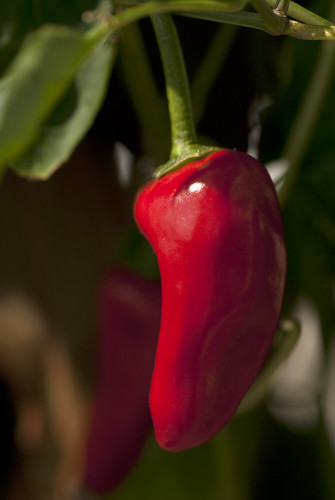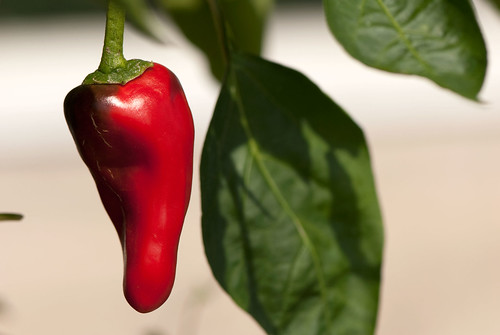Hot Peppers Add Incomparable Flavors, Aromas to Meals
Posted in Exhibitions, Programs and Events, The Edible Garden on August 11 2009, by Plant Talk
 |
Maricel E. Presilla is a culinary historian specializing in the foods of Latin America and Spain. She will be presenting at this Thursday’s Edible Evening. |
 Unlike most Cubans, I adore hot peppers—in every size, shape, and form. When I first introduced them to my garden I started cautiously, first planting the hot cultivars that I knew would grow best in the warm, humid summers of New Jersey, where I live. But soon I began to scour the Internet for new sources of pepper seedlings, seeds, and whole pods, discovering that a single keyboard’s click could take me to a treasure trove of peppers, both hot and sweet, at online sites.
Unlike most Cubans, I adore hot peppers—in every size, shape, and form. When I first introduced them to my garden I started cautiously, first planting the hot cultivars that I knew would grow best in the warm, humid summers of New Jersey, where I live. But soon I began to scour the Internet for new sources of pepper seedlings, seeds, and whole pods, discovering that a single keyboard’s click could take me to a treasure trove of peppers, both hot and sweet, at online sites.
After three years I had graduated to about 100 cultivars from seeds and seedlings obtained in the U.S., with at least three seedlings of each specimen. (My collection represented the five domesticated species of the genus Capsicum: Capsicum annuum, C. baccatum, C. chinense, C. frutescens, and C. pubescens, all New World natives originating in South America.)
The peppers occupied not only every sunny patch of soil in my backyard but also an array of containers set on our brick patio, perched on garden tables and chairs, and overflowing onto the three garden tables I’d improvised from long planks of Ipe wood resting on metal sawhorses along our narrow driveway.
In return, by October I had vistas of beautiful, thriving plants with fruits of all colors and shapes, shining like miniature Christmas trees. What is best, my edible gardening project became the foundation of a pepper glossary for Saveur magazine appearing in the September 2009 issue (A World of Peppers: Chiles Bring a Lot More to the Table than Just Heat).
It was harder to label the 48 selected peppers accurately and keep their identities straight for the story than to grow them in my garden. Peppers are among the easiest food plants to grow, requiring a minimum of attention: the right amount of sunlight, judicious watering (peppers don’t like wet feet), and an initial boost of an organic fertilizer (I used fish and seaweed emulsion).
I harvested enough peppers to supply my two restaurants, Zafra and Cucharamama in Hoboken, N.J., and had enough leftovers to cook at home and use for testing recipes. Even my dozen hens benefited from the experiment. I fed them peppers along with their fresh greens and was rewarded with the yellowest, tastiest eggs that I had ever eaten.
The experience made me wiser in the way of peppers and taught me much about their proclivities and flowering habits, a key to species identification. For instance, I found that habaneros and all members of C. chinense thrive in New Jersey’s warm and moist weather while the chubby silver-leaved Andean rocoto (C. pubescens, a cousin of the Mexican ají chile manzano), a lover of cooler nights and higher altitudes, needed sheltering from direct sun, producing fewer fruit as late as November.
Nurturing so many peppers in a single season gave me an immense appreciation for their beauty and amazing range of pod types as well as for their endless versatility as cooking ingredients. All peppers contribute incomparable flavor, color, and aroma to any dish, but hot peppers do much more, bringing sweet, sour, and salty flavors into sharper focus.
The ají amarillo (C. baccatum), a bright yellow-orange pepper that is a staple in Peru and Bolivia, is deliciously fruity with a mild tingling heat. Lightly roasted and cut into strips, it is stunning in cebiches and escabeches, a perfect counterpoint to the acidity of the sauce. Pureed with salt, garlic, and cumin, it is a perfect seasoning paste for all kinds of meats and delicious as the base for cooking sauces.
The meatier and much hotter red rocoto and the Central America and Mexican manzano give body and terrific color to an Indian-inspired apple chutney, while the deep herbal-flavored aribibi peppers from Bolivia (C. chinense) look like live caterpillars in a mixture of pickled peppers. Even the so-called ornamental peppers like the showy Bolivian rainbow (C. annuum) with its lovely purple-hued pod are terrific raw in fresh salsas, where you can show off their beautiful colors.
Latin America is the undisputed cradle of all peppers, and it is no wonder that for millennia peppers have been the backbone of our cooking. We love our many peppers from the sweetest to the hottest. We chop them and slice them to stir into our cooking sauces (sofritos). We dry them, smoke them, roast them on hot griddles, reconstitute them in water, and grind them to a paste to enrich our marinades (adobos). And when it comes to adding a final splash of color to a special dish we often turn our back on more flavorful local favorites and yield to the easy, sweet, bright charm of Spanish-style fire-roasted pimientos (pimentos) in a can or a jar.
A Note on my Favorite Spanish Pepper
 As you walk through The Edible Garden, look for a small pepper called Pimiento de Padrón (C. annuum, pictured at left and above). These tiny, thin-skinned peppers from Galicia, Spain, are delicious pan-fried in olive oil with just a sprinkling of coarse sea salt.
As you walk through The Edible Garden, look for a small pepper called Pimiento de Padrón (C. annuum, pictured at left and above). These tiny, thin-skinned peppers from Galicia, Spain, are delicious pan-fried in olive oil with just a sprinkling of coarse sea salt.
Lore has it that a friar at the Franciscan monastery of San Antonio de Padua in Herbón, a parish of the municipality of Padrón in the province of A Coruña, brought the pepper seeds from Mexico and planted them in the monastery’s vegetable garden (huerta). I imagine the early peppers were hot, becoming tamer through human manipulation.
That genetic memory kicks in when the growing season is excessively warm or the peppers are left to ripe for too long. It is not uncommon to find a few peppers in a bunch that are hot enough to make you gasp. For many Padrón pepper lovers, the unexpected jolt is a bonus. “Uns pican e outros non. E a gracia do pimento” (“Some bite, some don’t. It is the beauty of the pepper), says my Galician assistant Paloma Ramos.
Lucky for all of us with an appetite for these Galician marvels, David Winsberg, a Florida-born farmer who relocated to California in the 1970s, grows about 6,000 pounds of them each year at his two-acre Happy Quail Farms in East Palo Alto. The closest pepper to these Galician marvels is the Japanese shishito pepper.
For my take on cooking with these delicious peppers, see my recipe on Saveur.com.

